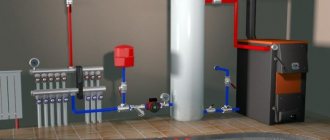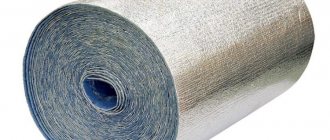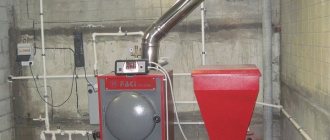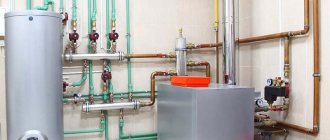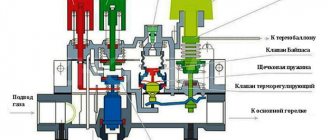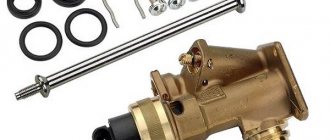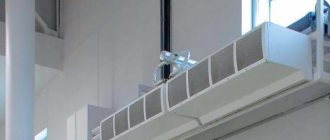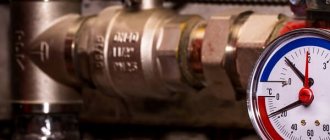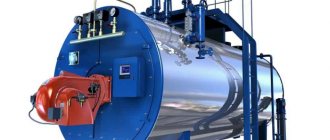Home / Boiler rooms
Back
Published: 05/14/2019
Reading time: 2 min
0
5624
Boiler lining is a complex and high-tech process that includes installation of a system of fireproof and heat-insulating boiler enclosures designed to protect the room from gas waste and insulate the combustion chamber. This design is a combined system of brick, insulating materials, mortar, metal frame and sheathing.
Not afraid of high temperatures and changes, the influence of combustion products and gases. To increase efficiency and prevent heat loss, the design must be technically robust, not complicated in design and not interfere with the installation of the boiler.
- 1 What is boiler lining
- 2 Purpose of lining
- 3 Types and features of lining
- 4 Technology of lining boiler equipment
Varieties
The main purpose of the protective layer is to reduce the level of heat loss and the risk of burns for workers, and energy costs are also reduced. Particular attention is paid to the materials used to create the lining and the technology of formation. There are several basic schemes, each of which is selected individually and has a high level of efficiency:
- The pipe lining of the boiler consists of lightweight concrete, characterized by thermal insulation characteristics. The outer layer is made using chromite mass and special plates.
- The frame scheme consists of three layers: mineral wool, diatomaceous earth concrete and chamotte concrete.
- Heavy has a limited scope and is only suitable for boiler rooms with a maximum temperature level within 800 degrees. The outer layer is red brick, the inner layer is made of refractory bricks.
Types of protection for open type boilers
The purpose of the protective coating is to prevent burns for operating personnel and reduce heat losses from the heating system. Properly done lining of the DKVR-10-13 boiler will reduce the heat transfer coefficient from pipes with steam and reduce current energy costs
It is important to select the technology for forming a protective belt and materials for its implementation. After all, lining a boiler means creating an effective protective layer around the entire structure
Classification by type of construction:
- Heavy. Used for systems with relatively low power and maximum temperatures up to +700°C. The inner layer is formed from half-thick refractory brick, the outer layer is made from standard red brick.
- Nakarkasnaya. It consists of three layers: chamotte concrete (60 mm), reinforced diatomite concrete (50 mm), and mineral wool slabs.
- Natrubnaya. First, a 40 mm thick chromite mass is applied, then a layer of lightweight thermal insulating concrete (50 mm). Final processing is carried out with heat-insulating boards.
The specific lining scheme for the DKVR-10-13 boiler depends on the chosen technology and the materials used. The latter will determine the performance of the equipment and the degree of efficiency of its operation.
Materials for lining
Forming a protective layer is a complex technological process. Companies providing this service make the compositions themselves, depending on the type of boiler and technical conditions. Thus, the lining of NIISTRU-5 boilers can be radically different from the work on protecting heating equipment of other types. The list of materials for completing this task is the same, the difference is in the composition and layers applied.
For example, you can consider how the lining of a DE 16 13 boiler is done, the consumption of materials and the stages of work.
- Preparation of stuffing masses. The base is chromite, carbundum or corundum components. Liquid glass or a slip of refractory clay is used as a binder. The volume depends on the thickness of the layer (up to 50 mm) and the area of the packing.
- Sealing compounds. First, a mounting mesh made of refractory metal is installed on the surface of the ramming masses. Fireclay powder, fluffed asbestos or caustic magnesite are used. Application is possible only before the mass hardens. In total, the volume of the lining of the DKVR 10 13 boiler can reach large values. On average, the mass is 1 m? area is 1.2 tons.
- Installation of thermal insulation boards. Basalt fiber is used for this, as it can withstand temperatures up to +1200°C.
In addition, not the entire structure may be processed. In some cases, it is advisable to protect individual elements. Most often, the S645 745 boiler door is lined with Plistix to prevent accidents and reduce heat losses. In this case, it is necessary to take into account the temperature distribution on the surface of the equipment. When cooling, there should be no zones with a sharp change in heating.
Boiler lining repair also has its own characteristics. When dismantling the harness, they try to save the elements for reuse. If, during operation, unevenness has formed in pipes or intermediate screens, they need to be leveled with a layer of heat insulation. To improve performance properties, aluminum paints are used to paint the boiler lining. They are applied on top of the last layer.
Peculiarities
The lining of hot water boilers is a labor-intensive process that requires adherence to technology and competent selection of materials. Stuffing compounds are produced on a corundum, carbundum or chromite base. Liquid glass often acts as a binding base. The amount of mass produced depends on the surface requiring processing and the required thickness.
The composition applied to the surface is covered with a special mesh made of fire-resistant material. The sealing coating is made with magnesite, asbestos or fireclay powder. It is worth noting that coating can be carried out if the mass has not yet hardened.
Preparation and placement of ramming masses on the surface of screens[edit]
For laying on the screen surfaces of boilers, ramming masses are used: chromite, chromite-magnesite, carborundum and corundum.
In carborundum masses, liquid glass, refractory clay slip, sodium tripolyphosphate and an aluminophosphate binder based on orthophosphoric acid are used as a binder.
Carborundum mass with a phosphate binder has the best performance properties.
The compositions and properties of the ramming masses are given in Table. 9.15.
Table 9.15. Compositions and properties of ramming masses.
| Name of mass | Mass composition | Maximum application temperature, °C | Density, kg/m3 | Linear expansion coefficient (at temperature 20 – 800°C) | Thermal conductivity coefficient (at temperature 300 – 700оС), W/m×оС |
| 1 | 2 | 3 | 4 | 5 | 6 |
| Chromite | Chromite mixture CX-1 or CX-2, liquid glass with a density of 1.4 - 1.5 g/cm3, 7% to the chromite mixture | 1350 | 2500 – 3200 | (7,0 – 8,0)×10– 6 | 1,1 – 1,3 |
| Carborundum | Black silicon carbide No. 160-63 – 40%, No. 50-12 – 30%, silicon carbide slurry – 30%, binder over 100%: liquid glass with a density of 1.3 g/cm3 – 6%, an aqueous suspension of refractory clay with a density of 1 .13 g/cm3 – 5% | 1500 | 2100 – 2300 | 5,5×10– 6 | 4,0 – 4,5 |
| Carborundum with phosphate binder | Black silicon carbide No. 160-63 – 40%, No. 50-12 – 30%, silicon carbide slurry – 30%, binder over 100%: aluminophosphate binder – 18%, refractory clay – 6% | 1700 | 2100 – 2300 | 8,9×10– 6 | 2,0 – 3,0 |
| Carborundum with phosphate binder | Black silicon carbide No. 160-63 – 40%, No. 50-12 – 30%, silicon carbide slurry – 30%, binder over 100%: refractory clay – 5%, tripolyphosphate – 3% | 1600 | 2300 – 2500 | 5,5×10– 6 | 5,5 – 7,2 |
| Carborundum with phosphate binder | Black silicon carbide No. 160-63 – 40%, No. 50-12 – 30%, silicon carbide slurry – 30%, binder over 100%: orthophosphoric acid – 15%, electrocorundum – 10%, refractory clay – 6% | 1500 | 2100 – 2300 | 4,1×10– 6 | 4,0 – 6,0 |
| Corundum with aluminophosphate binder | Corundum No. 400-100 –25%, refractory clay – 25 – 35%; binder over 100%: phosphoric acid 75 percent - 15% | 1650 | 2100 – 2400 | 7,6×10– 6 | 0,8 – 1,2 |
| Chromium-magnesite | Chromomagnesite grain composition: grain from 7 to 3 mm – 40%, from 1 to 0.09 mm – 30%, less than 0.09 mm – 30%; binder over 100%: liquid glass with a density of 1.4 - 1.5 g/cm3 - 10%, sodium fluorosilicone - 1%, fireproof clay - 6% | 1500 | 2600 – 2800 | 10,3×10– 6 | 1,0 – 1,5 |
The compositions and properties of heat-resistant concrete are given in section 10.
Before preparing the stuffing masses you must:
- — dilute liquid glass with water and bring it to the specified density;
- - dry the refractory clay, grind it and sift through a sieve with holes no larger than 1 mm;
- - dissolve refractory clay in water;
- — the density of the clay suspension should be 1.13–1.15 g/cm3.
It is allowed to prepare carborundum of fine grain composition by grinding larger grains in ball mills with steel grinding media.
The masses are prepared in paddle mixers. The dry components are poured into the mixer and mixed for 3 minutes, then the liquid components are loaded in any order without stopping the mixer. After loading all components into the mixer, the mass is stirred for 10 minutes.
Prepared ramming masses, especially chromite and carborundum, are used within 1.5 hours from the moment of preparation. To prevent drying and hardening, the mixtures should be stored in closed containers. Re-use of the set mass is not allowed.
Before laying the ramming masses, studded and smooth screen pipes, chambers and other steel surfaces must be sandblasted. On incendiary belts, the mass is thrown onto the spiked pipes immediately over a sufficiently large area and stuffed in such a way that the layer of compacted mass above the spikes is 3–5 mm. It must be taken into account that packing the mass in several layers at certain intervals of time causes its stratification.
The mass is compacted with pneumatic hammers through a steel plate measuring 200×200 mm, 12–15 mm thick. The mass is packed tightly, without voids between the pipes and spikes. The degree of compaction is checked by pressing the thumb with a force of 10–15 kg. In this case, no noticeable mark should remain on the surface of the mass.
When laying the mass on the underside of boilers with liquid slag removal, burner embrasures, etc., it is recommended to lay the mass in layers no more than 100 mm thick. The mass is compacted using pneumatic shovels or manually using wooden tampers. If it is necessary to lay a second layer, the surface of the previously laid layer is cut into 80x80 mm squares to a depth of 7–8 mm. It is advisable to carry out laying of the masses, especially with a large layer thickness, without interruption. It is advisable to dry the mass immediately after installation, passing hot water at a temperature of 60 ° C through the screens.
What you need to know
Basalt fiber, which is highly resistant to temperature, is used to form thermal insulation boards.
In some cases, partial lining of the boiler becomes more rational. Reducing thermal energy losses and ensuring the safety of operating personnel is possible by treating the doors of the structure. In this case, it is necessary to pay attention to the temperature distribution during cooling.
Repair of boiler linings begins with dismantling the piping, while it is advisable to preserve the base of the structure for future use. If there are uneven areas on the screens and pipes, you can apply a layer of thermal insulation. The service life of the structure can be increased due to aluminum coloring compounds used as a finishing coating.
INTRODUCTION
In recent years, the designs of linings for steam boilers at power plants have undergone significant changes.
The old heavy brick linings were replaced by new lightweight ones, made from heat-resistant and heat-insulating concrete and ramming masses, as well as from prefabricated heat-insulating slabs, protected on the fire side by a layer of heat-resistant plaster. Such changes occurred as a result of a high degree of shielding of the walls of the combustion chamber of modern boilers, the development and implementation of new compositions and structures made of heat-resistant and heat-insulating concrete and ramming masses. Due to a sharp decrease in temperature behind the screens (up to 500 - 600 ° C), the ratio of the individual layers of lining changed: instead of the thickness of the refractory layer 125 - 250 mm
in old brick linings, the thickness of the fireproof or heat-resistant layer in the lining of modern boilers does not exceed 50
mm
, and the weight of the refractory layer has decreased from 80% of the total weight of the lining to 40%.
With a high degree of shielding of the combustion chamber, the need to use highly refractory materials for lining elements that can withstand temperatures of up to 1500 ° C and higher (burning belts, stuffed hearths, unshielded sections of the furnace walls, etc.) cannot be ruled out.
A significant reduction in the weight of the lining has contributed to the spread of new designs in which the weight of the lining is completely transferred to the screen pipes (pipe lining) or a lightweight frame (on-frame lining).
Pipe linings are made of a layer of refractory concrete or a layer of chromite masses applied directly to the screen pipes, a layer of thermal insulation and sealing plaster.
Frame linings are made from prefabricated panels filled with heat-resistant and heat-insulating concrete or temperature-resistant heat-insulating boards, protected on the outside with sealing plasters.
The introduction of heat-resistant and highly efficient heat-insulating concrete, as well as mineral wool, sovelite, perlite and other slabs into the lining made it possible to create reliable designs for boiler linings and reduce heat loss through the lining to the level of modern standards (Zalkind E.M., Thermal calculation of the lining of a steam boiler, Energy, 1965).
Boilers “DKVR”
Systems of this series are designed to provide heated water and heat supply. They produce saturated steam and are often used in ventilation systems. The design has distinctive features in the form of vertically placed pipes and two drums. Boilers of this brand have many positive aspects:
- wide power range;
- use of any type of energy carrier, including fuel oil and gas;
- automated operation of the system;
- assembly of the structure can be carried out in the boiler room, without the need to dismantle the walls;
- lining of DKVR boilers is made from any materials suitable for the intended operating mode;
- the reliability of the aerodynamic and hydraulic system ensures a high level of efficiency.
Boiler room auxiliary equipment
In order for heat transfer processes to occur effectively in the boiler, all flows of water, fuel and air must undergo a preparation process before being supplied to the unit. These tasks are performed by auxiliary boiler installations.
Group of pumps in a boiler room
The auxiliary elements of the boiler unit include the following devices:
- fuel supply systems;
- smoke purification systems;
- draft devices;
- and pumps responsible for the movement of water along the circuit;
- boiler separation devices;
- water treatment plant.
Draft devices include smoke exhausters and fans operating in the gas-air duct system of the boiler. The former serve to create a vacuum in the combustion chamber and remove flue gases through the chimney into the atmosphere.
They are installed between the flue and the chimney, usually outside the boiler room, at the back of the boiler, due to the high noise level generated during operation.
Fans are designed to force air into the combustion chamber, to create a gas-air mixture at the outlet of the gas burner, to ensure complete combustion of the fuel. The device is also installed outside the boiler house building, but in front of the boiler front.
Separation devices are used to separate steam from boiler water; they are installed in the upper drum of the boiler. The water treatment system purifies feed water from hardness salts in sodium cation exchanger filters to reduce scale formation processes on the boiler heating surfaces of the boiler and removes active oxygen in the deaeration-feeding unit to reduce corrosion processes in the internal heating surfaces of the heat generator.
To power steam boilers, at least two electric pumps are installed, with an operating pressure of at least 1.25 pressure of the boiler water path, and a productivity of 110% of the rated steam output of all operating boilers.
In addition, two steam pumps are installed with at least 50% of the boiler room’s rated output.
Boiler room pumps are divided into:
- Feeding - designed to supply feed water to the boiler.
- Make-up tanks - for recharging the heating circuit in case of coolant leaks in the main networks.
- Network for coolant circulation in the supply and return pipelines. They are also used for hot water boiler houses.
- HVO pumps - in the chemical water treatment system.
- Gas equipment.
Boiler lining: technology
A mandatory step before lining is a hydraulic test of boilers. Next, the lining of the boiler surface and external cladding are performed. The materials used for lining must have fire-resistant properties, and it is also necessary to carefully sift fireclay powder, sand and clay before use. Cement, refractory and red clay should not contain foreign inclusions, lumps and small debris.
Before starting work, it is necessary to prepare a refractory mixture, tools and bricks of the same size. Each row of masonry must be checked with a building level to prevent the formation of depressions and bulges. You can check the quality of the corners using a steel square. As it becomes clear, the lining of steam boilers is a rather complex process that requires compliance with all norms and rules, so the work can only be undertaken if you have the knowledge and relevant experience. In most cases, it is better to contact specialists, since even a minor mistake can lead to serious consequences in the future.
Peculiarities
The insulating layer must be free of cracks and chips. Before laying refractory fireclay bricks, they are sorted; the material must be of the same size without damage. The use of broken or cracked bricks is strictly prohibited, as this significantly reduces the strength of the structure. Rough edges also reduce the tightness of seams.
Solution
The mixture used for masonry is no less important. It should have a uniform structure without inclusions. A solution based on clay and fireclay powder is suitable for laying fireclay bricks. The degree of fat content of the clay determines the amount of powder. It is worth noting that salt and river sand cannot be added to the composition, despite the fact that such ingredients are often found in mortars for laying stoves.
The thickness of the mixture during complex lining should be within 2 mm; with conventional masonry, an increase of up to 3 mm is allowed. The result obtained directly depends on maintaining the proportions of the ingredients and thorough mixing. The consistency should be medium thick. The solution is mixed only with clean water, this guarantees the absence of lime and other impurities. It is recommended to prepare the composition in a separate, pre-cleaned container.
Water heating boiler lining: description
Before starting work, all used elements must be cleaned of solution drops, corrosion and dirt. The connection points of the reinforcement are connected with wire with a diameter of about 2 mm or welded using electric welding. The use of aluminum and copper wire is undesirable.
Bitumen is applied in an even layer to the reinforcement and fixing elements necessary to strengthen the concrete.
Coniferous wood is used to make formwork, with the exception of larch. The sides adjacent to the concrete mortar are carefully processed and planed. It is possible to use paper or clay with high plasticity to seal cracks in the formwork. Double formwork is suitable for lining a vertical surface or one located at an angle of at least 40 degrees. It is recommended to coat the wooden surface with a lubricant to avoid adhesion to the concrete. A solution consisting of water and mineral oil can be used as a lubricant.
Furnaces and boilers in industry today remain indispensable objects, so there is often a need to repair and modernize such structures. In addition, the boiler must be lined and, if necessary, damaged elements must be replaced.

